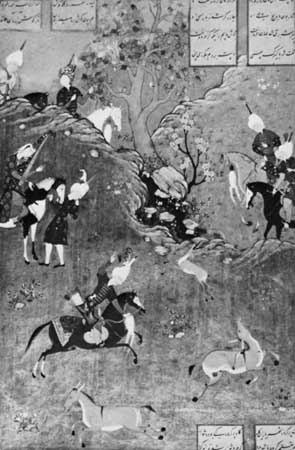Muẓaffar ʿAlī
Persian artist
flourished c. 1540—c. 1576
Persian miniaturist and calligrapher known best for his elegant human figures in rich, lyrical settings, who painted during the great flowering of Persian painting under the Ṣafavid shahs.
 He was the son of the Ṣafavid painter Haydar ʿAlī and a relative of the great painter Behzād, who is said to have taught him at Tabrīz. Muẓaffar ʿAlī was a favourite painter of Shah Ṭahmāsp I and became one of the leaders of the school of Qazvīn. He worked on the shah's great Shāh-nāmeh with other royal miniaturists and on a series of 14 illustrations for the khamseh executed between 1539 and 1543 under the shah's supervision. He probably worked on the Haft awrang of Jāmī made for Prince Ibrāhīm Mīrzā between 1555 and 1565. All three manuscripts are acknowledged masterpieces of Persian painting. He trained two of the outstanding painters of the next generation, Siyavūsh and Sadiqī, and is said to have designed and partly executed wall paintings for the palace and for the Chihil Sutūn (“Hall of Forty Columns”) at Qazvīn.
He was the son of the Ṣafavid painter Haydar ʿAlī and a relative of the great painter Behzād, who is said to have taught him at Tabrīz. Muẓaffar ʿAlī was a favourite painter of Shah Ṭahmāsp I and became one of the leaders of the school of Qazvīn. He worked on the shah's great Shāh-nāmeh with other royal miniaturists and on a series of 14 illustrations for the khamseh executed between 1539 and 1543 under the shah's supervision. He probably worked on the Haft awrang of Jāmī made for Prince Ibrāhīm Mīrzā between 1555 and 1565. All three manuscripts are acknowledged masterpieces of Persian painting. He trained two of the outstanding painters of the next generation, Siyavūsh and Sadiqī, and is said to have designed and partly executed wall paintings for the palace and for the Chihil Sutūn (“Hall of Forty Columns”) at Qazvīn.- Hench, Philip Showalter
- Henck Arron
- Hencke, Karl Ludwig
- Henderson
- Henderson, Alexander
- Henderson, Arthur
- Henderson, Fletcher
- Henderson, Lawrence Joseph
- Henderson, Rickey
- Henderson, Sir Nevile Meyrick
- Henderson, Thomas
- Hendrick de Keyser
- Hendricks, Thomas A
- Hendrick Zwaardecroon
- Hendricus Sneevliet
- Hendrika Mastenbroek
- Hendrik Anthony Kramers
- Hendrik Antoon Lorentz
- Hendrik Christoffel van de Hulst
- Hendrik Conscience
- Hendrik Frensch Verwoerd
- Hendrik Goltzius
- Hendrik Marsman
- Hendrik Petrus Berlage
- Hendrik Potgieter